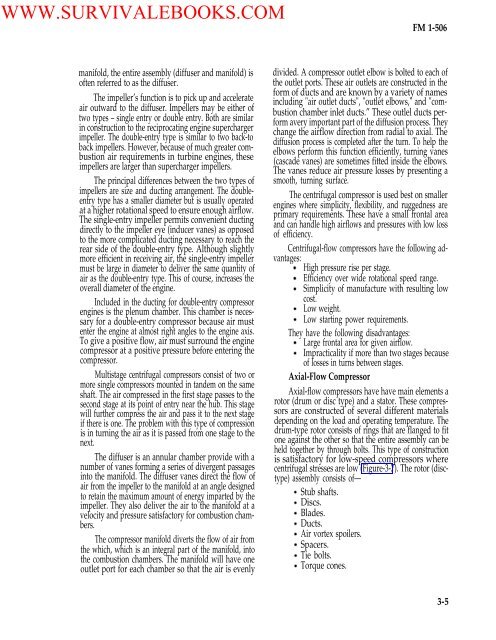FM 1-506 Fundamentals of Aircraft Power Plants ... - Survival Books
FM 1-506 Fundamentals of Aircraft Power Plants ... - Survival Books
FM 1-506 Fundamentals of Aircraft Power Plants ... - Survival Books
You also want an ePaper? Increase the reach of your titles
YUMPU automatically turns print PDFs into web optimized ePapers that Google loves.
WWW.SURVIVALEBOOKS.COM<strong>FM</strong> 1-<strong>506</strong>manifold, the entire assembly (diffuser and manifold) is<strong>of</strong>ten referred to as the diffuser.The impeller’s function is to pick up and accelerateair outward to the diffuser. Impellers may be either <strong>of</strong>two types – single entry or double entry. Both are similarin construction to the reciprocating engine superchargerimpeller. The double-entry type is similar to two back-toback impellers. However, because <strong>of</strong> much greater combustionair requirements in turbine engines, theseimpellers are larger than supercharger impellers.The principal differences between the two types <strong>of</strong>impellers are size and ducting arrangement. The doubleentrytype has a smaller diameter but is usually operatedat a higher rotational speed to ensure enough airflow.The single-entry impeller permits convenient ductingdirectly to the impeller eye (inducer vanes) as opposedto the more complicated ducting necessary to reach therear side <strong>of</strong> the double-entry type. Although slightlymore efficient in receiving air, the single-entry impellermust be large in diameter to deliver the same quantity <strong>of</strong>air as the double-entry type. This <strong>of</strong> course, increases theoverall diameter <strong>of</strong> the engine.Included in the ducting for double-entry compressorengines is the plenum chamber. This chamber is necessaryfor a double-entry compressor because air mustenter the engine at almost right angles to the engine axis.To give a positive flow, air must surround the enginecompressor at a positive pressure before entering thecompressor.Multistage centrifugal compressors consist <strong>of</strong> two ormore single compressors mounted in tandem on the sameshaft. The air compressed in the first stage passes to thesecond stage at its point <strong>of</strong> entry near the hub. This stagewill further compress the air and pass it to the next stageif there is one. The problem with this type <strong>of</strong> compressionis in turning the air as it is passed from one stage to thenext.The diffuser is an annular chamber provide with anumber <strong>of</strong> vanes forming a series <strong>of</strong> divergent passagesinto the manifold. The diffuser vanes direct the flow <strong>of</strong>air from the impeller to the manifold at an angle designedto retain the maximum amount <strong>of</strong> energy imparted by theimpeller. They also deliver the air to the manifold at avelocity and pressure satisfactory for combustion chambers.The compressor manifold diverts the flow <strong>of</strong> air fromthe which, which is an integral part <strong>of</strong> the manifold, intothe combustion chambers. The manifold will have oneoutlet port for each chamber so that the air is evenlydivided. A compressor outlet elbow is bolted to each <strong>of</strong>the outlet ports. These air outlets are constructed in theform <strong>of</strong> ducts and are known by a variety <strong>of</strong> namesincluding "air outlet ducts", "outlet elbows," and "combustionchamber inlet ducts.” These outlel ducts performavery important part <strong>of</strong> the diffusion process. Theychange the airflow direction from radial to axial. Thediffusion process is completed after the turn. To help theelbows perform this function efficiently, turning vanes(cascade vanes) are sometimes fitted inside the elbows.The vanes reduce air pressure losses by presenting asmooth, turning surface.The centrifugal compressor is used best on smallerengines where simplicity, flexibility, and ruggedness areprimary requirements. These have a small frontal areaand can handle high airflows and pressures with low loss<strong>of</strong> efficiency.Centrifugal-flow compressors have the following advantages:High pressure rise per stage.Efficiency over wide rotational speed range.Simplicity <strong>of</strong> manufacture with resulting lowcost.Low weight.Low starting power requirements.They have the following disadvantages:Large frontal area for given airflow.Impracticality if more than two stages because<strong>of</strong> losses in turns between stages.Axial-Flow CompressorAxial-flow compressors have have main elements arotor (drum or disc type) and a stator. These compressorsare constructed <strong>of</strong> several different materialsdepending on the load and operating temperature. Thedrum-type rotor consists <strong>of</strong> rings that are flanged to fitone against the other so that the entire assembly can beheld together by through bolts. This type <strong>of</strong> constructionis satisfactory for low-speed compressors wherecentrifugal stresses are low (Figure-3-7). The rotor (disctype)assembly consists <strong>of</strong>—Stub shafts.Discs.Blades.Ducts.Air vortex spoilers.Spacers.Tie bolts.Torque cones.3-5
















